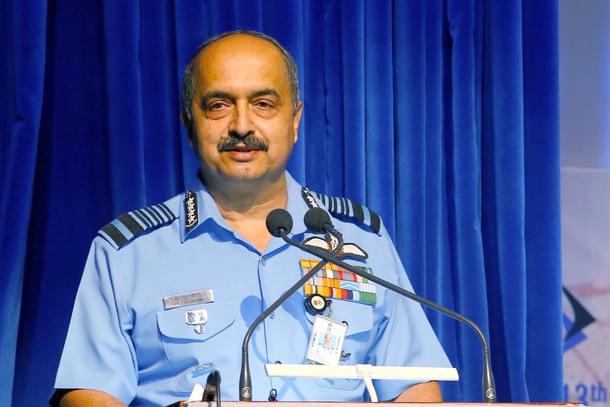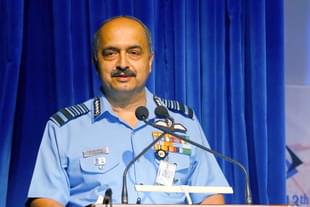Defence
From Combined China-Pakistan Threat To Modernisation Plans Worth 3 Lakh Crore, Five Things Air Chief Marshal Said In His Annual Press Conference
Ujjwal Shrotryia
Oct 04, 2023, 04:36 PM | Updated 04:36 PM IST
Save & read from anywhere!
Bookmark stories for easy access on any device or the Swarajya app.


In a recent statement by the Indian Air Force (IAF) Chief, Air Chief Marshal V R Chaudhari stated that the IAF is looking to buy weapons systems worth Rs 2.5 lakh crore to 3 lakh crore in the next 7-8 years.
He was speaking at an annual press conference held in New Delhi, where he addressed questions from various journalists.
Here are the five things the Chief said about the IAF's future procurement plans, India-China border standoff, China-Pakistan combined axis against India, and China's military infrastruture modernisation in Tibet.
(1) About Combating Combined China-Pakistan Threat
Acknowledging the China-Pakistan axis and its combined threat to India, he pointed out that China and Pakistan are engaged in technology transfer, with "Pakistan manufacturing JF-17 fighter aircraft and inducting the J-10."
He stated “We keep an eye on the developments between these two countries.”
He stressed that the IAF possesses the necessary equipment, tactics, and training to effectively counter any threats posed by the adversary, even in situations where numerical superiority may not be in their favor.
He said "in places where the adversary cannot be countered in sheer numbers, it will be countered through better tactics and training and this also holds true for situations arising due to a strong collusion between Pakistan and China."
Chaudhari highlighted IAF's commitment to dynamic operational planning, constantly adapting strategies based on evolving border situations and persistent monitoring of border developments using various Intelligence-Surveillance-Reconnaissance (ISR) assets.
“Our focus remains dynamic at all times, we do not have a fixed mindset in terms of deployment of assets in particular areas, but we have flexible and dynamic war plans which we keep revising every now and then based on the ISR inputs we get,” he said.
(2) About India-China Standoff
To tackle the challenge posed by China's enhanced air defence capabilities, including an array of radars and Surface to Air Guided Weapon (SAGW) systems along the northern borders, India is implementing the mountain radar project.
ACM Chaudhari explained that "India will seek to counter it with its mountain radar project, under which mountain radars will be placed in strategic locations to help see deep inside adversary territory," adding “we have lightweight radars which we keep deploying and redeploying based on what we see developing across the border."
He further added "the IAF’s operational plans are amended based on where these radars and SAGW systems are deployed."
Talking about the ongoing military standoff with China in eastern Ladakh, he said, while some disengagement has occurred at certain points along the LAC, complete disengagement is yet to be achieved, and the IAF will maintain its presence until a full resolution is achieved.
Regarding infrastructure development in Tibet, Chaudhari mentioned the expansion of air facilities along the LAC. Nine Advance Landing Grounds (ALGs) have become operational and open for civil use in the Northeast.
Additionally, clearances have been granted for the construction of an airstrip in Nyoma, eastern Ladakh, Chaudhari said.
Permanent infrastructure improvements, such as hardened aircraft shelters and weapon storage areas, are also underway to secure assets deployed in border areas.
(3) About Fighter Squadron Shortfall
Chaudhari emphasized the necessity for the IAF to maintain an authorized strength of 42 squadrons of fighter jets, considering the evolving threats that India faces, particularly in light of China's advanced platforms.
The Chief stated "the IAF’s requirement to have an authorised strength of 42 squadrons of fighter jets will remain given the existing threats faced by India, particularly from the new technology platforms possessed by the adversary today."
Currently, the IAF's inventory comprises only 30 fighter squadrons.
(4) About Weapons Procurement
Discussing the IAF's procurement plans, ACM Chaudhari mentioned that the IAF has significant procurement initiatives in progress. These include the acquisition of 97 additional indigenous Light Combat Aircraft (LCA) Mk-1A fighter jets, estimated to cost around Rs 1.15 lakh crore.
Additionally, the IAF plans to purchase 156 Light Combat Helicopter (LCH) Prachand, of which 66 are designated for the IAF.
“The contract value we anticipate is Rs 45,000 crore," talking about the total cost for acquiring 156 Prachand helicopters, he said, adding, "we have already signed a Rs 6,000 crore contract for 70 HTT-40 trainer aircraft. We also have in the pipeline the upgrade of SU-30MKI, 84 of them, the value of which is anticipated to be a little over Rs 60,000 crore.”
Numerous other contracts worth approximately Rs 2.5-3 lakh crore are currently underway. They include the procurement of Light Combat Helicopters (LCH), HTT-40 trainer aircraft, upgrades to SU-30MKI aircraft, and various missile systems.
"The weapons systems — Akash-NG, medium-range surface-to-air missile (MR-SAM), air defence system Kusha, ballistic missile system Pralav, and so on are among the contracts that the IAF is expecting to sign in the coming year," Chaudhari stated.
“The overall value of these contracts will be well past 2.5-3 lakh crore and the contracts will be expected to be fulfilled in about 7-8 years. We will plan our budget accordingly,” the Air Chief added.
He also expressed optimism that the remaining two of the five S-400 air defense systems from Russia would be delivered by the next year.
ACM Chaudhari noted progress in the Multirole Fighter Aircraft deal, pending a decision on whether it will be an inter-governmental deal or follow the Defense Acquisition Procedure 2020.
(5) About IAF's Role in Humanitarian Operations
ACM Chaudhari also underscored the crucial role played by the IAF in humanitarian assistance and disaster relief (HADR) missions, both domestically and internationally.
The IAF has been instrumental in recent global HADR efforts, such as 'Operation Kaveri' and 'Operation Dost.'
“We carried out Operation Kaveri to evacuate our citizens from Sudan, where we flew 22 sorties (115 Hr), extricated 2100 persons and carried 58 tonnes of critical load. During ‘Operation Dost’ to aid Turkiye and Syria, we flew 28 sorties (188 Hr) and carried 307 tonnes of load," he said.
Staff Writer at Swarajya. Writes on Indian Military and Defence.





